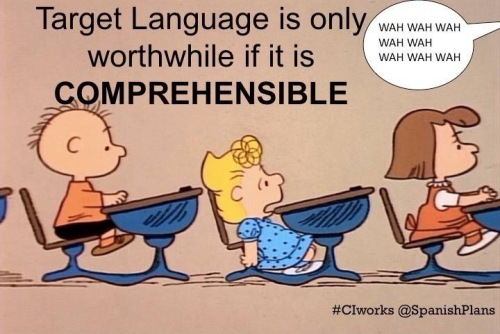Comprehensible input is not a teaching method. It is not a fad. It is simply how we acquire language.
My Aunt and her family spoke Spanish. Her husband, my Uncle , was a monolingual American. He tortured his children by only listening to the Spanish station on the radio. He said that by listening to that station one day he would be able to speak Spanish. The problem is, he never learned to speak or understand Spanish. He received a lot of input in Spanish, but it wasn’t comprehensible to him. It was not tailored to his needs and therefore he never “picked up” the language.
The problem with the radio is that he had nothing to anchor what he was hearing. If it had been television or a magazine he would have seen images that might have increased his comprehension.
In strict immersion settings teachers are told to simply speak the target language and the students will sink or swim. Well what about the kids who sink? We can not allow this to happen. We must not leave any students in the class behind.

The input must be comprehensible and it must be comprehended. We must make our language and any resources understandable to our students if we want them to acquire language.
How can we make sure we are comprehensible?
1- Teach to the eyes.
2- Have a signal for students to use when they don’t understand
3- Go slowly
4- Repeat and rephrase MANY more times than you think is necessary
All language teachers provide input for their students. In the most successful language classes the input is 100% comprehensible and engaging for the students. As my district moves towards creating a new curriculum I hope we will keep in mind the need for our content to be interesting and personalized to our students’ needs.
I have struggled so many times with the “daily chores” unit. Nearly every novice level textbook includes a unit on chores. This is not compelling stuff. I can make it interesting for a day or two, but after that I flounder. The problem is that it’s not really necessary for the communication goals of my students. My students want to be able to communicate with peers. They want to be able to talk about themselves and others and hold basic conversations. I can’t remember ever having a student whose true passion in life was dusting and vacuuming. So why do we do it?
We do it because the textbook tells us we should. I think we need to take a step back and think about what we value. What are the goals of our language program? What do we want kids to be able to do with the language in our class and beyond? My feeling is that if we can provide them with enough compelling, personalized and comprehensible input they will reach intermediate level after 3 or 4 years and at that point they will be able to seek out the topics that interest them and become independent language learners.
What are the textbook units that drive you crazy? And do you have a thought on how to make it better?

I couldn’t agree more. I personally despise the volunteer unit. It could be so much more interesting by relating volunteer work in with a travel unit as a viable option for students to travel with purpose.
LikeLike
Yes. Let’s make it something they might be able to use and be interested in.
LikeLike
Ha, funny. A student asked me today why we are learning the word “acid rain”. In our Spanish 4 unit, we are learning about the environment and while many words are very relevant and good conversation pieces, I had to admit to the student that I probably hadn’t used the word “acid rain” ever in the last 10 years. 🙂 There are great units out there that could certainly use a lift to more relevant terms that students will find engaging.
LikeLike
Yikes. Textbooks really date themselves with those vocab lists. VCR? Acid Rain? Pager?
LikeLike
I love your anecdote about your uncle. I think it really helps to break down the idea of comprehensible input.
Also, we’re in the middle of chores right now in German 2. Ugh.
LikeLike
The chores unit is awful! I ended up doing a movie talk to try to make it more interesting. I ended up using the textbook’s video from 1997 though…
LikeLike